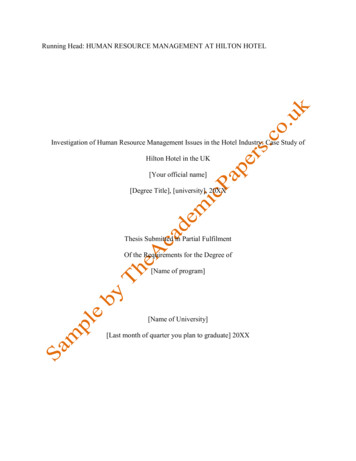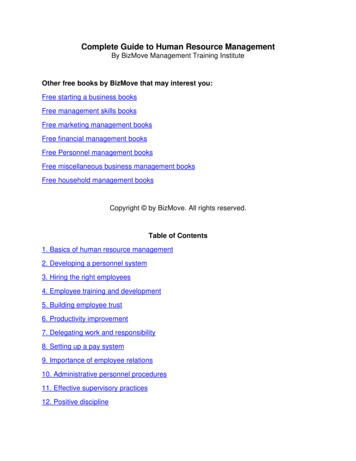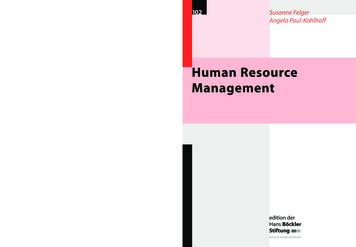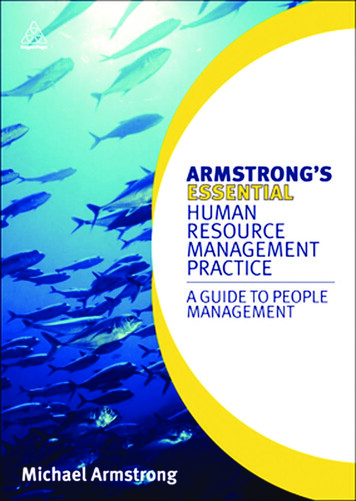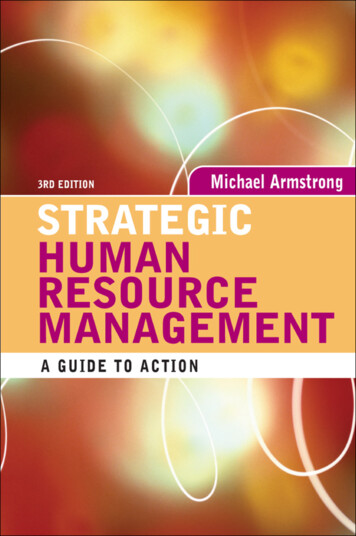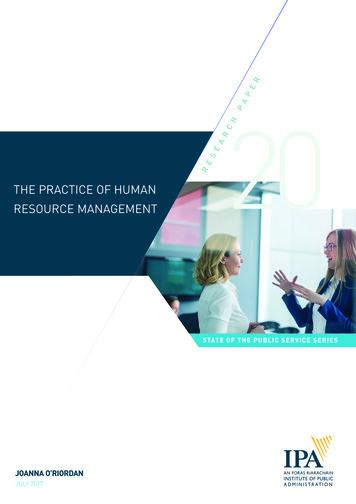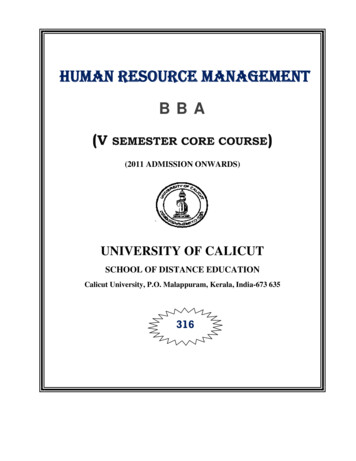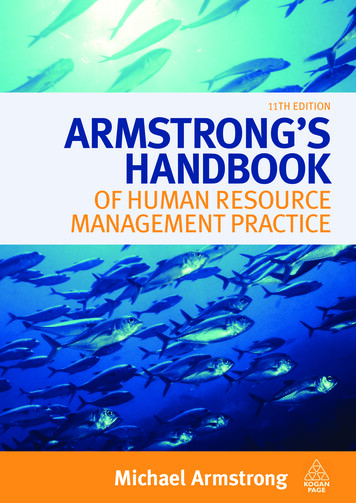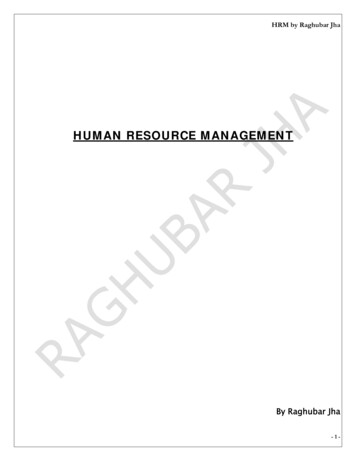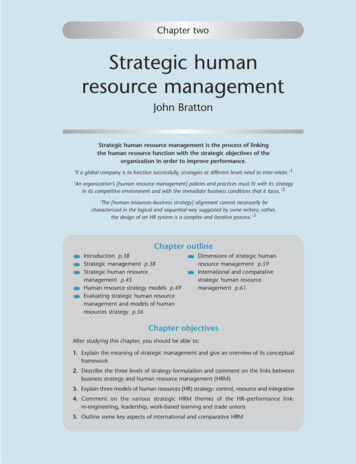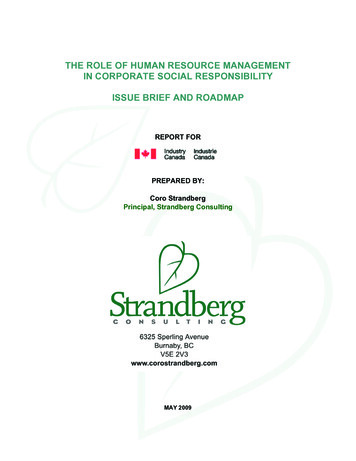
Transcription
Biyani's Think TankConcept based notesHuman Resource ManagementMBA (II SEM)Richa KhuntetaSurbhi MathurDept of MBABiyani Institute of Science & Management,Jaipur
2Published by :Think TanksBiyani Group of CollegesConcept & Copyright : Biyani Shikshan SamitiSector-3, Vidhyadhar Nagar,Jaipur-302 023 (Rajasthan)Ph : 0141-2338371, 2338591-95 Fax : 0141-2338007E-mail : acad@biyanicolleges.orgWebsite :www.gurukpo.com; www.biyanicolleges.orgFirst Edition : 2011While every effort is taken to avoid errors or omissions in this Publication, any mistake oromission that may have crept in is not intentional. It may be taken note of that neither thepublisher nor the author will be responsible for any damage or loss of any kind arising toanyone in any manner on account of such errors and omissions.Leaser Type Setted by :Biyani College Printing Department
Human Resource Management3PrefaceI am glad to present this book, especially designed to serve the needs of the students. Thebook has been written keeping in mind the general weakness in understanding the fundamentalconcepts of the topics. The book is self-explanatory and adopts the “Teach Yourself” style. It isbased on question-answer pattern. The language of book is quite easy and understandable basedon scientific approach.Any further improvement in the contents of the book by making corrections, omission andinclusion is keen to be achieved based on suggestions from the readers for which the author shallbe obliged.I acknowledge special thanks to Mr. Rajeev Biyani, Chairman & Dr. Sanjay Biyani,Director (Acad.) Biyani Group of Colleges, who are the backbones and main concept providerand also have been constant source of motivation throughout this Endeavour. They played anactive role in coordinating the various stages of this Endeavour and spearheaded the pub lishingwork.I look forward to receiving valuable suggestions from professors of various educationalinstitutions, other faculty members and students for improvement of the quality of the book. Thereader may feel free to send in their comments and suggestions to the under mentioned address.Author
4ContentsS.NoTitle of Chapter1Human Resource Management: An Introductionand Scope2Job Design and Job Analysis3Training and Development4Performance Measurement and PerformanceAppraisal5Leadership and Grievance6Discipline7Employee Compensation8Key Terms & Terminologies
Human Resource Management5Annexure1. Bibliography-672. Solved question papers-68 - 823. Multiple Choice Questions-83 - 85
6SyllabusObjectives:To become a successful manager of people, students need to understand behavior of humanresources in various organizational situations. In a complex world of industry and business,organizational efficiency is largely dependent on the contribution made by the human resourcesof the organization. The objective of this course is to sensitize students to various facts ofmanaging people and to create an understanding of the various policies and practices of humanresource management.Section AHuman Resource Management-. Introduction and Scope, HRD-Concept, Need, Human ResourcePlanning-Concept, Process, job design-Concept approaches, job analysis, job description, jobspecification. Human Resource Procurement-Recruitment. Selection and induction.Training, Training phases, Need Assessment, Establishment, Establishment of Trainingobjectives, Training method Lecture, case method, Role playing. Business in Basket T- Group,Incident, Syndicate, Evaluation of a training Programme. Performance measurement and rewardsystems-introduction, performance drivers, leadership and performance, reward managementperformance appraisals. Discipline. The grievance procedure.Employee compensation-purpose and importance, components. non monetary rewards, workersparticipation in Management Employee. Strategic challenges for leadership, career management,SHRM Mergers and acquisitions.Section BCase and ProblemsDean, Rajasthan Technical University, Kota/ 2008-2009/Prof. Surendra Kumar Vyas, ChairmanBoS, Department of Management & Technology, Engineering Co llege, Bikaner.
Human Resource Management7Chapter 1Human Resource Management: An Introduction andScopeQ.1 What is Human Resource Management?Ans. Human Resource Management (HRM) is the process of managing people in organizationsin a structured and thorough manner. This covers the fields of staffing (hiring people), retentionof people, pay and perks setting and management, performance management, changemanagement and taking care of exits from the company.Importance of Human Factor:1.Output will be greater than the input2.Each individual is different from culture, education, environment, background etc3. We can‟t purchase the loyalty, dedication, devotion towards the organization.4.Time passes human factor can bring experience to organization to accept the challenges5. Recent developments like legislation, trade unions enhanced their importance. Apart fromabove factors there are certain other factors that one should consider in the management of humanresource such as:
8Q .2 Explain the difference between Personnel Management and HRM?Ans.DimensionsPersonnel ManagementHRMBeliefs and assumptions1. ContractCareful delineation ofwritten contractsAim to go beyondcontract2. RulesImportance of devisingclear rules/mutually'Can-do' outlook;Impatience with 'rule'3. Guide to managementactionProceduresBusiness-need'4. Behavior referentNorms/custom andpracticePluralistValues/mission6. Nature of relationsStrategic aspectsUnitarist
Human Resource Management98. Key relationsLabor managementCustomer9. InitiativesPiecemealIntegrated11. Speed of decisionSlowFast12. Management roleTransactional13. Key managersPersonnel/ iness/linemanagers14. CommunicationIndirectDirect16. Management skillsNegotiationFacilitation17. SelectionSeparate, marginal taskIntegrated, key task18. PayPerformance-related19. ConditionsJob evaluation (fixedgrades)Separately negotiated21. Thrust of relationswith stewardsRegularized throughfacilities and training22. Job categories andgrades23. CommunicationManyMarginalized (withexception of somebargaining for changemodels)FewRestricted flowIncreased flow24. Job designDivision of laborTeamworkLine manage mentKey leversHarmonization
10Q. 3 Discuss the nature and scope of HRM?Ans. 1. Organizations are the people who manage.2. HRM involves acquisitioning, developing, maintaining3. Decisions relating to employees must be integrated.4. Decisions made must influence the effectiveness of an organization.5. HRM functions are confirmed to Non-business organization also.Scope of HRMNature ialRelationMoti vationMaintenance
Human Resource Management11Q. 4 What is the significance of Human Resource Development(HRD)?Ans. Human resource development (HRD) is an essential component for growth and economicdevelopment. It can occur at both the nationwide level and the firm-wide level.The need & importance of HRD can be measured from the following points: Growth of organization: Growth of organization is associated with the development of itsworkforce. In changing situation HRD must be viewed as the total system interrelated andinteracting with other systems at work: production, finance, and marketing. Development of work culture : The need of HRD is felt as it improves the efficiency ofemployees, checks monotony at work, better communication, development of mutualcooperation and creativity of all the members comes into limelight. Developing potentialities: The focus of HRD manager essentially is on enabling people toself-actualize through a systematic approach by which their existing talents are furtherdeveloped. Growth of employees: HRD is associated with growth of employees. It helps employees toknow their strengths and weaknesses and enable them to improve their performance. Themanagement should provide adequate opportunity for the development of human resourcemanagement for the development of their talents so that their development will benefits theorganizational growth. Country Develops if The Human Resource is Developed:To enhance economic development the state constructs roads, buildings bridges, dams, power houses,hospitals, etc. to run these units doctors, engineers, scientist, teachers, are required. So if the stateinvests in a human resource it pays dividend in response. Entrepreneurship Increase:Education, clean environment, good health, investment on the human resource, will all have itspositive effects. Job opportunities would be created in the country. And even business environmentwill flourish in the state which creates many job opportunities.Q.5 What is Human Resources planning and also explain its components?Ans. E.W Vetter viewed human resources planning as “a process by which an organization shouldmovefrom its current manpower position to its desired manpower position. Through planning managementstrives to have the right number and right kind of people at the right places at the right time, doing thingswhich result in both the organization and the individual receiving maximum long-run benefit”.According to Leon C Megginson human resources planning is an integrated approach to performing theplanning aspects of the personnel function in order to have a sufficient supply of adequately developedand motivated people to perform the duties and tasks required to meet organizational objectives andsatisfy the individual needs and goals of organizational members.Components of Human Resource Planning comprises:
12Estimating Manpower RequirementWorkload analysisWorkforce analysisAbsenteeismLabor turnoverRecruitment & SelectionInduction & developmentPersonnel DevelopmentEnsuring quality to products & servicesOverall assessment & performance & fine- tuningQ.6 Discuss the process of Human Resource Planning.1. Analyzing the Corporate Level Strategies : – Human Resource Planning should start with analyzingcorporate level strategies which include expansion, diversification, mergers, acquisitions,reduction in operations, technology to be used, method of production etc. Therefore HumanResource Planning should begin with analyzing the corporate plans of the organization beforesetting out on fulfilling its tasks.2. Demand forecasting: – Forecasting the overall human resource requirement in accordance with theorganizational plans is one of the key aspects of demand forecasting. Forecasting of quality ofhuman resources like skills, knowledge, values and capabilities needed in addition to quantity ofhuman resources is done through the following methods: a. Executive or Managerial Judgment: – Here the managers decide the number of employees inthe future. They adopt one of the three approaches mentioned below: oBottom-Up approach: – Here the concerned supervisors send their proposals to the topofficials who compare these with the organizational plans, make necessary adjustments andfinalize them.oTop-Down approach: – Here the management prepares the requirements and sends theinformation downwards to the supervisory –level who finalizes the draft and approves it.oParticipative Approach: – Here the supervisors and the management sit together andprojections are made after joint consultations.The chief drawback of these methods is that estimation of manpower is made using guesswork.b. Statistical Techniques: – These methods use statistical methods and mathematical techniquesto forecast and predict the supply and demand of Human Resources in the future.
Human Resource Management13c. Ratio-Trend analysis: – In this method depending on the past data regarding number ofemployees in each department, like production department, sales department, marketingdepartment and workload level, etc ratios for manpower are estimated. Past values are plotted andextrapolated to get fairly accurate future projections.d. Work Study method: – This technique is suitable to study the correlation between volume ofwork and labor i.e. demand for human resources is estimated based on the workload. Work studymethod is more appropriate for repetitive and manual jobs when it is possible to measure workand set standards.e. Delphi Technique: – „Delphi’ Technique is named after the Greek Oracle at the city of Delphi.In this method, the views of different experts related to the industry are taken into considerationand then a consensus about the Human Resource requirement is arrived at. Delphi technique isused primarily to assess long-term needs of human resource.3.Analyzing Human Resource Supply: – Every organization has two sources of supply of HumanResources: Internal & External. Internally, human resources can be obtained for certain poststhrough promotions and transfers. In order to judge the internal supply of human resources infuture human resource inventory or human resource audit is necessary. Human resource inventoryhelps in determining and evaluating the quantity of internal human resources available. Once thefuture internal supply is estimated, supply of external human resources is analyzed.4. Estimating manpower gaps : – Manpower gaps can be identified by comparing demand andsupply forecasts. Such comparison will reveal either deficit or surplus of Human Resources in thefuture. Deficit suggests the number of persons to be recruited from outside, whereas surplusimplies redundant employees to be re-deployed or terminated. Employees estimated to bedeficient can be trained while employees with higher, better skills may be given more enrichedjobs.5. Action Planning: – Once the manpower gaps are identified, plans are prepared to bridge thesegaps. Plans to meet the surplus manpower may be redeployment in other departments andretrenchment. People may be persuaded to quit voluntarily through a golden handshake. Deficitcan be met through recruitment, selection, transfer and promotion. In view of shortage of certainskilled employees, the o
Human Resource Management 13 c. Ratio-Trend analysis: – In this method depending on the past data regarding number of employees in each department, like production department, sales department, marketing department and workload level, etc ratios for manpower are estimated. Past values are plotted and extrapolated to get fairly accurate future projections. d. Work Study method: – This .

